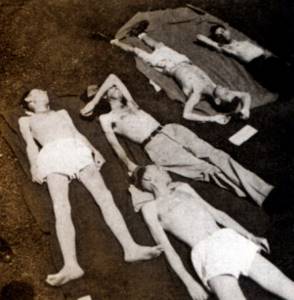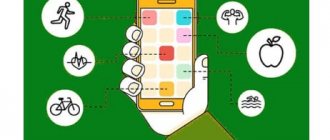Minnesota experiment
I read about this experiment a long time ago.
The experiment was conducted in 1944 by Dr. Ancel Keys in Minneapolis, Minnesota.
The purpose of the experiment was to overcome the effects of catastrophic exhaustion after the end of World War II. At that time there was no adequate scientific information on this matter.
Keys's plan was simple:
- Bring the experiment participants to a state very close to exhaustion.
- Return to normal diet.
All participants were volunteers. These were those young people who did not want to do military service for any reason.
The experiment was supposed to last a year.
- First three months: NORMAL diet, the same for all participants.
- Next six months: FASTING.
- Last three months: REHABILITATION (increasing caloric intake).
Keys received more than 400 applications to participate, despite the fact that he warned about the possible dire consequences of prolonged fasting.
He selected 36 young men.
The experiment began in November 1944.
Here are some features of their daily activities:
- People lived in the laboratory, in dorm-type bedrooms.
- There were classrooms, a library, and a recreation room nearby.
- Work 15 hours a week in the laundry, cleaning the laboratory, helping in the kitchen.
- They attended 25 hours of political training classes.
- A week they walked 35 kilometers along the street at a moderate pace and half an hour on a treadmill.
- Periodically, they underwent physiological and psychological tests (mathematics, listening memory, etc.).
- It was necessary to provide samples of semen, blood, urine, stool, saliva and bone marrow.
The first three months started out pretty well. Participants received approximately 3,500 calories per day.
By the end of the three-month period, each participant had to reach their ideal weight. Some received a little more, others a little less (depending on weight). The participants began to weigh close to their ideal weight.
Then the most interesting period began. Starvation. For six months.
Participants were fed TWICE a day. At 08:00 and at 17:00.
Three types of menus that changed one after another. It included potatoes, white grain bread, cereals, cabbage, turnips, rutabaga. Sometimes meat (small portions), sugar, milk, butter were given.
The approximate average calorie intake was 1570 kcal.
Also, individual body features were taken into account.
- Thin people only had to lose 19% of their body weight.
- Thick: up to 28%.
The average reduction in body weight in the group was around 24%.
Every day, the subjects made adjustments to their diet depending on the achievement of the goal. Those who lost weight too quickly received more carbohydrates (potatoes and bread), those who lost weight slowly received reduced portions.
Immediately, from the first days of the experiment, mental apathy became visible.
Previously, the subjects discussed politics, sex, relationships, but now they practically ceased to be interested in this.

Irritability and aggressiveness were often observed when food intake was delayed.
The dishes were ordinary, but people enjoyed every spoonful.
Between meals you could chew gum as much as you wanted, drink water and black coffee without sugar.
They chewed 40 packs of gum a day!!! And we drank 15 cups of coffee.
Over time, the subjects tried to dodge, deceive Keys and take food without his knowledge. They had to have guards assigned to them.
The subjects began to have nightmares.
One participant, during his next trip to the city, bought himself an ice cream and a milkshake and could not tear himself away from them.
Then, Keys called this test subject (his name was Franklin Watkins) to his place for a personal conversation. The young man, during a conversation with Ancel Keys, simply burst into tears, and then he had an attack of anger, during which he threatened to kill Keys and then himself.
Franklin had to be sent to the psychiatric ward of the university hospital.
But a few days later he was released, as Franklin began to return to normal after returning to his normal diet.
Changes as a result of the experiment
From the very beginning, as you remember, all participants had an approximate body weight of 70 kg.
How further body changes occurred during fasting:
- After the start of fasting, the subjects began to lose weight sharply, they began to turn into walking skeletons.
- At the sixteenth week, physiological changes became visually noticeable to any person (refined facial features, protruding cheekbones, atrophied muscles, protruding collarbones, narrower shoulders, protruding ribs, protruding shoulder blades, protruding spine, etc.). Even the fatty tissue in the buttock area disappeared, the skin began to hang in folds. It became painful to sit; I had to put pillows under my butt.
- The heartbeat slowed. It was 55 beats per minute, now it's 35 beats per minute.
- “By and large” they started going to the toilet once a week.
- Blood volume dropped by 10%.
- The size of the heart muscle has decreased.
- Swelling of the face was observed due to drinking large amounts of water.
- Rough skin.
- Constant dizziness, muscle pain, ringing in the ears, unnatural whiteness of the eyes.
- What’s strange is that vision returned to normal, and hearing improved (the body adapted some systems to increase survival).
Despite the fact that the whole thing looked terrible, the participants in the experiment began to think that they were normal, and that other people were fat (this is observed in patients with anorexia).

And also, endurance and strength indicators decreased. It was hard to climb the stairs, take a shower, or even lift the inkwell.
The most interesting thing is that there were no problems with vitamins. Apparently, due to the consumption of potatoes and other vegetables rich in vitamins.
The Minnesota subjects were constantly cold, even in the hot summer they wore jackets. It was difficult for them to listen to loud music and even noisy conversations.
Gradually, the participants in the experiment began to feel that their minds and souls were changing.
Their company became dull and very apathetic, they preferred loneliness, had outbursts of anger, and were afraid to make decisions.
Libido disappeared completely. They didn't want sex.
The testicles began to produce less hormones, sperm were few and less mobile.
Everyone had apathy, depression, nervousness, and emotional instability.
Rehabilitation
The average weight of the subjects dropped to 52 kilograms (previously it was 70).
Rehabilitation proceeded as follows.
Keys divided the subjects into 4 subgroups:
- I received 400 calories per day more than before.
- I received 800 calories per day more than before.
- I received 1200 calories per day more than before.
- I received 1600 calories per day more than before.
Some received additional vitamin and protein supplements to see how this affected rehabilitation.
After a few weeks, it turned out that these supplements were of no use to the test subjects.
Men from the first subgroup (who ate 400 calories more per day) DID NOT RECOVER AT ALL!
Conclusion: As a result of the experiment, it turned out that in order to return the body to a normal state, the subjects needed to consume about 4000 calories per day.
How did the experiment end?
Now the subjects could eat what they wanted.
Keys continued to monitor some with their consent during a period of “unlimited rehabilitation.”
- It was noticed that men began to eat 5-10 THOUSAND calories per day. Moreover, they admitted that they could not satisfy their hunger, no matter how much they ate.
- Four months after the end of the fasting period, all participants began to eat about 3200-4200 calories per day.
- All participants EXCEEDED their pre-experiment weight.
- Those who entered the experiment dry and fit now had rounded shapes.
- After 5 months, libido returned.
- The heart returned to normal size.
- Lung volume has been restored.
- Shortness of breath appeared due to excess weight.
- Good manners have returned.
Quote from the conclusion:
“The experiment showed that adult men are not able to obtain significant rehabilitation on 2000 kcal/day. A more reasonable result is 4000 kcal/day, at least for several months. The composition of the diet is important, but if there are few calories coming in, then additional protein supplements and minerals are of no use.”
What is the plateau effect
The plateau effect when losing weight is a phenomenon as a result of which weight does not decrease, and in some cases even weight gain occurs. In the process of losing weight, with a purposeful and competent approach, relatively rapid weight loss occurs at first. Subsequently, the kilograms begin to fall off relatively more slowly.

Plateau effect when losing weight
Sometimes situations occur when, even with all the previous loads and nutrition, the weight remains unchanged. Often in such cases people become frustrated and lose motivation. Giving up the fight would be a completely wrong decision, since there are ways to break through stagnation.
Note! First you need to identify the cause of this condition and develop a strategy to get out of it. Despite all the negative aspects, the plateau also has a positive aspect. It is during the period of stagnation that the achieved result is recorded in the body.
The weight stopped while losing weight. TWO main reasons for stopping fat burning
Did you notice that not a single participant in the Minnesota experiment had any “plateau” in weight loss?
Why? After all, the weight should stay in one place?
Yes, this is possible, but for a very short period, because... Even a slowdown in metabolism cannot prevent further weight loss due to insufficient caloric intake.
Absolutely ALL participants in the experiment lost weight. How so?
The fact is that based on scientific data, it was found that two reasons can contribute to stopping fat burning on a diet:
- Violation of the regime (often unconscious).
- New balance point.
Let's figure out what these reasons are.
Violation of the regime
The stricter the diet, the more you sit on it, depleting your energy reserves, the more often it happens that you violate your diet and your activity.
Most likely, you are not doing this on purpose. Unconsciously.
The body tries to minimize energy expenditure while tricking you into eating more.
This is an amazing adaptation mechanism.
You begin to snack more and more, grab and eat some snacks on the fly, start consuming cheat meals more often, and stop noticing that you are eating something forbidden that is not included in your grocery list.
At the same time, you try to minimize energy costs by reducing your physical activity.
Previously, let’s say you ran on your feet for half a day, but now you try to drive or sit more.
The body prevents unfavorable fat burning by using all its adaptive reserve mechanisms.
If you don't specifically focus on what you eat and how you move, your weight may no longer move down.
This is the MOST POPULAR reason for stopping fat burning on a diet. It seems to you that I eat what I need, move, train, and the weight stays off.
In fact, you can add a lot of calories every day with your snacks. Remember in the last article I talked about my client who gained 800 extra calories a day in this way?
New balance point
This reason is more rare than the first, but it also occurs.
Our body has amazing adaptation mechanisms. The body tries to adapt to any environmental conditions if possible.
The body perceives caloric restriction as new conditions of existence to which it must adapt. If these restrictions go smoothly and not in large quantities (as on a diet), then the body is able to get used to them.
Over time, the body learns to maintain its energy consumption at the level of energy supply from food and nutrients that you have created for it.
The point is that those food restrictions that once allowed you to lose weight will no longer be sufficient, and the current amount of food will no longer be scarce.
In other words, your body reaches a NEW POINT OF EQUILIBRIUM!!!
This means that you will stop losing weight on the same amount of food you eat.
To put it simply, this is called “slowing metabolism.”
If this happens, then you need to:
- Or cut down on calories a little more.
- Or increase your caloric intake for 2-4 weeks.
You can find out whether the metabolism has slowed down during drying or not by:
- Body temperature.
- The state of the autonomic nervous system.
By body temperature . It's simple: the lower the body temperature, the lower the metabolic rate. The higher the body temperature, the higher the metabolic rate.
In numbers it looks like this:
- 36.9-37.0 C = 105-110% of normal metabolism (acceleration).
- 36.6 = 100% (normal metabolism).
- 36.0 C = 90% of normal metabolism (slowdown).
- 35.5 C = 80% of normal metabolism (severe slowdown).
- 35.0 C = dangerously slow metabolism, which can lead to death.
This body temperature is indicated for measurement UNDER THE ARM, because... The temperature may vary in different parts of the body.
According to the state of the autonomic nervous system.
The autonomic nervous system is a section of the nervous system that regulates the activity of internal organs, endocrine and exocrine glands, blood and lymphatic vessels. It plays a leading role in maintaining homeostasis (balance) of the internal environment of the body and in adaptive reactions.
The ANS regulates salivation, heart rate, blood pressure, etc.
It is divided into:
- Sympathetic system (intensifies metabolism, activates organs, excites tissues).
- Parasympathetic system (restoration of energy resources).
These systems must be in equilibrium.
If the balance is disturbed, the activity of the sympathetic system decreases, and the parasympathetic system increases, then METABOLISM SLOW DOWN .
Such changes in the balance of the autonomic nervous system can be tracked by the following signs:
- Redness of the skin (not paleness).
- Low blood pressure.
- Slowing heart rate.
- Excessive salivation (lots of saliva).
- Frequently need to go to the toilet (increased urination).
- Lethargy (really want to sleep).
- The mood is apathetic, calm.
With these simple signs of body temperature and the autonomic nervous system, you can understand what is happening with your metabolism.
If you are very lethargic, frequently run to the toilet, and have low blood pressure, then you have probably cut your calories too much and your metabolism has slowed down.
Lose weight slowly
Stubborn kilograms can only give in if you approach them slowly, more “softly”, evenly and relentlessly. You can achieve this by cutting your daily caloric intake by 500 calories and gradually increasing the intensity of your exercise.

In this case, there will be sustainable, and most importantly safe, weight loss at a rate of approximately 1% of weight per week. If you weigh 75 kg, you will lose an average of 700-800 grams per week. Believe me, even 500 grams per week is great! The main thing is dynamics. How much will it be in a year?
How to continue fat burning if progress has slowed down
I think you are wondering how to solve this problem.
We have figured out how to understand that there is a problem, now I will tell you how to solve it.
How to Cope with Breakdowns and Restore Metabolic Speed on a Low-Carb Diet
The question is complex, but solvable.
As a rule, such a violation of the regime (decreased activity and snacking) is unconscious!
The brain tries to force you by any means to consume excess food in order to prevent fat burning.
A person may tearfully claim that he continues to follow a diet, but in reality he eats a lot of excess food between planned meals, plus he reduces physical activity.
One of the reasons why metabolism is inhibited is a DECREASE IN LEPTINA LEVELS in the blood.
Leptin is a peptide hormone that regulates energy metabolism. Or, in simple terms, the “satiety hormone.”
The more leptin, the less you want to eat. Leptin suppresses appetite.
On a diet, leptin levels are constantly low. Why? Find out below.
On a diet, we must spend more energy every day than we get from food. All this is directly regulated by leptin through the hypothalamus.
If we limit ourselves in calories and carbohydrates, then the concentration of leptin drops over time . This leads to a slowdown in metabolism.
Weight loss stops. The diet stops working.
Leptin acts in a complex manner. Not only does it act on your central nervous system through the hypothalamus to signal your metabolism to slow down.
It simultaneously affects your pancreas, kidneys, sympathetic nervous system and immune system.
What happens when you have a LOT of leptin in your body:
- Acceleration of energy expenditure (fat burns faster).
- Accelerated satiety (no hunger).
- Decreased insulin secretion.
- Go to the toilet more often (urine production increases).
- Stimulation of immune cells.
- Accelerated bone growth and increased bone density.
Leptin is seen to play an important role in the effectiveness of the diet.
When there is a lot of leptin (in the first 2-4 weeks of the diet), you lose weight quite quickly. When leptin becomes low, fat burning slows down.
Additionally, strength training activates the leptin signaling system in the muscles ! Because of this, energy consumption increases and it seems to us that our metabolism has accelerated.
- Food = Leptin levels RISE (fullness).
- Hunger = Leptin levels FALL (we want to eat).
- We are fat = Leptin levels are HIGHER (it is easier for fat people to lose weight at the beginning of the journey).
- We are thin = LESS leptin levels (the last 5-10 kg are the hardest to lose).
- Lots of insulin in the blood (when we eat carbohydrates) = HIGHER leptin levels.
- Low insulin in the blood (if KETO diet) = LESS leptin level.
- We are freezing (cold) = Leptin levels DECREASE (it’s easier to lose weight in the summer).
You may have noticed that the main factor in reducing leptin in the body is FOOD, namely CARBOHYDRATES and, as a result, the production of INSULIN (transport hormone).
As soon as the body realizes that leptin levels have decreased, energy expenditure begins to slow down and the feeling of hunger increases.
With regular strength training, this feeling only gets STRONGER!
Which exit?
Use refeeds.
Refeed is a conscious increase in the amount of carbohydrates on a diet from several hours to several days and even weeks.
Refeeds can be very useful. Now I will explain why.
The point of carbohydrate refeeds is that you do not reduce your intake of the main source of energy (carbohydrates) to a large disadvantage.
You periodically, usually within 3-30 days, increase the amount of carbohydrates by 50-100%. That is, if you ate 150 g of carbohydrates per day on a diet, now you eat 225-300 g.
The scheme is as follows:
- Carbohydrates in the diet are ALWAYS in small quantities (diet).
- Periodic refeeds = LOTS of carbs (+50-100%).
When to use a refeed you need to decide along the way. Depending on how you feel. Usually the first month and a half of the diet are the simplest. Progress is fast, restrictions are minimal.
The problems start further. Lethargy, drowsiness, drop in strength, etc. It’s precisely under these conditions that you can make a refeed for a week. Then reduce calories again.
What does this give us:
- Energy consumption increases . Energy expenditure does not slow down due to good leptin levels and you can continue to lose weight without worry.
- No feeling of hunger . You eat your main source of energy (carbohydrates). Leptin is elevated. It gives you a feeling of satiety.
- Easier to follow a diet . Psychologically and physiologically. I have moments when I can no longer forcibly push chicken breast with buckwheat into myself. In such cases, refeeds come to the rescue.
- After the diet, the weight does not return . Your body receives a steady supply of carbohydrates and calories. The level of stress for the body is reduced and there is no need for emergency “storage”.
- Reduced muscle catabolism . Muscles are better preserved because... a certain level of insulin is present in the body every day (produced in response to the intake of carbohydrate foods).
- Good health and appearance . Bags under the eyes and puffiness disappear, muscles are filled with glycogen, lethargy and irritability disappear.
Cheat meals or refeeds?
I think many people have asked this question.
A cheat meal (from the English “cheat meal”) is a one-time or short-term violation of the diet in order to prevent a slowdown in metabolism and psychological relief on a diet.
I used to be a fan of cheat meals. I went on a no-carb BUT diet for a whole week, only to carb-load with a cheat meal over the weekend!
I binged on pizza, pancakes with condensed milk, Snickers, burgers, etc.
It often happened that over the weekend I limited all the achievements that were during the week. It was sad.
And it’s very difficult to always be in psychological tension due to the fact that there are no carbohydrates for a long time. This makes it very difficult to control yourself during a cheat meal.
Such swings were really stressful.
I found another solution for myself, to use refeeds.
When using refeeds, we CONTROL the concentration of leptin and the quality of the food we eat (rather than “throwing in” everything). When we use a cheat meal, leptin levels are uncontrolled (at first it skyrockets and then drops sharply). When cheating, we eat foods that are not healthy for our body.
The latest scientific research suggests that cheat meals don't work very well to speed up your metabolism, they work to fill your muscles with glycogen.
Conclusion: If you have diagnosed yourself with a slow metabolism on a low-carbohydrate diet, then use REFID for a period of 3-4 to 14-30 days. Then return to a nutritious diet.
All answers in the diary
Keeping a food diary will help a lot. Write down what, how much and when you ate daily. It is through fixing your diet that you can draw conclusions, make changes to your diet, set goals for the next week and move forward.
The food diary will allow you to see:
- How many calories do you consume and how many do you expend?
— Is there enough protein to not lose muscle mass?
- How much carbohydrates, fats, fiber and water.
— How much time was devoted to physical activity.
And of course, working with a nutrition consultant will help. It's all in the little things that only an experienced specialist can see.











